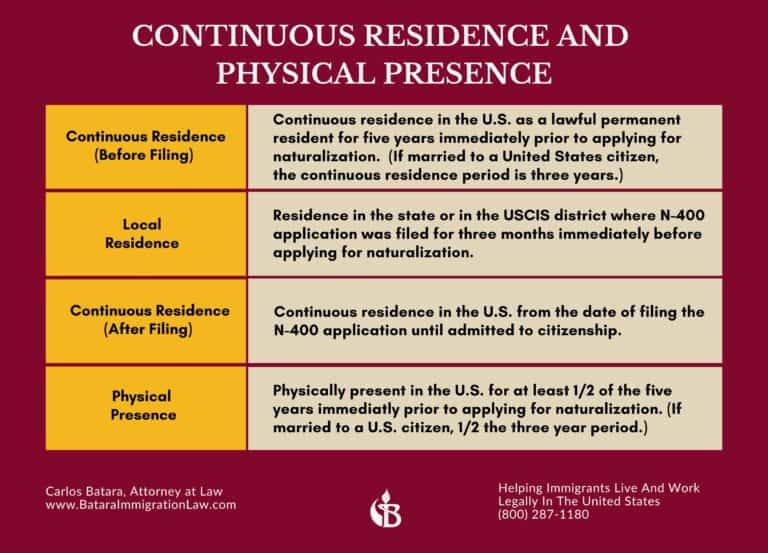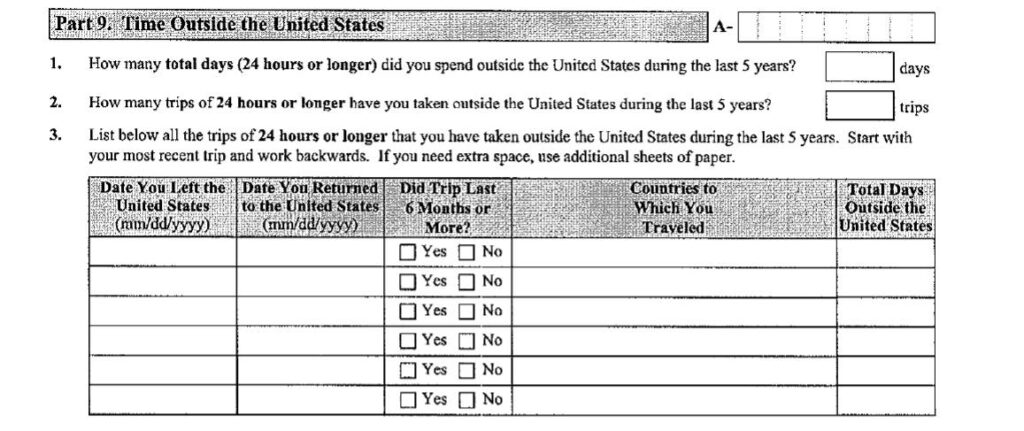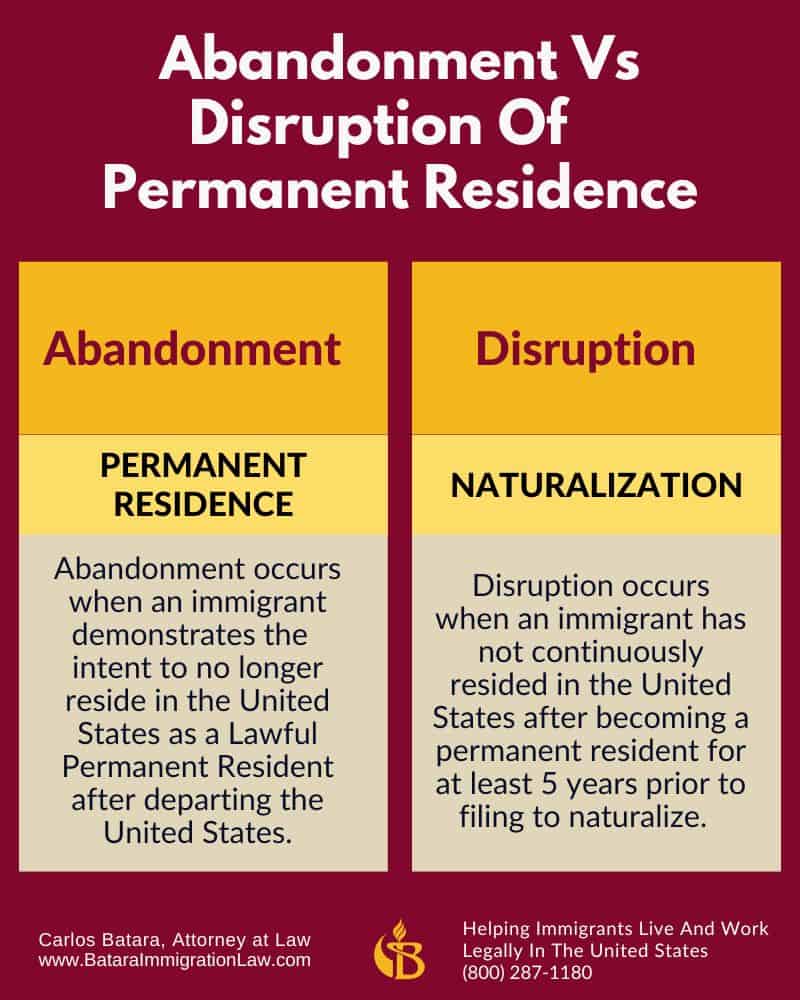
Often times permanent residents seeking naturalization suddenly find themselves facing deportation.
It’s not because they have a history of criminal convictions, failed to pay their taxes, or concealed information from the government in earlier filings.
Rather, their problems stem from something far less sinister – travelling abroad – and staying outside the United States too long.
Let’s examine how this happens.
Table Of Contents
- How Absences From The United States Can Affect Permanent Residents And Naturalization Applicants
- Two Concepts You Must Understand To Avoid The Perils Of Green Card Travel
- Residence And Presence Requirements For Naturalization
- What Does Continuous Residence Mean?
- Absences From The United States: Abandonment vs Disruption Of Residency
- Abandonment: Loss Of Permanent Resident Status
- Disruption: Ineligibility For Naturalization
- Travel Abroad With Caution
This article is based on the premise that all permanent residents, who qualify, should seek naturalization. However, the issue of abandonment, discussed below, applies equally to those residents with no such intentions.
How Absences From The United States Can Affect Permanent Residents And Naturalization Applicants
To qualify for naturalization, immigrants must prove that since becoming green card holders, they have abided by the rules to maintain their legal status.
One such issue pertains to a permanent resident’s exits and entries after winning a green card.
Upon winning permanent residence, many immigrants begin to take trips to visit family members who still live in their home country.
Unfortunately, many green card holders do not realize lengthy or multiple trips outside the United States might cause the government to assert they have not maintained their status and thereby forfeited their claim to residency.
In other cases, immigrants understand the risks, but carelessly disregard them.
Based on my citizenship and naturalization attorney practice, here are a few common examples how immigrants, travelling abroad, place their green card status in jeopardy.
Vishnu, born in India, obtained United States citizenship through marriage. After his father retired, his father and mother would visit the U.S. once per year for about four months until his father passed away. As an only child, Vishnu did not want his mother, Karishma, now in her late 70s, to live alone. He decided to sponsor her for permanent residence through consular processing. She had agreed to the plan.
But soon after she began living in the U.S., she had the urge to go back to her former village and see old neighbors and friends. She was not comfortable being in the U.S. without her deceased husband. Although she was aware that she needed to put time limits on her travels back to India, she would only stay in the U.S. a few months before leaving again.
**********
Leo met Aurora while stationed in the Philippines at an army base. Soon after his return to the United States, Leo filed a fiancé petition for her. She was granted a K-1 visa.
Sixty days later, they were married in a small chapel ceremony. They promptly filed her application for permanent residency. Aurora, who had never been outside her country before, missed her parents and siblings. Almost immediately upon winning legal status, she travelled back to her home country.
Thinking she could come and go freely between her two homes, she enrolled in a three-year course to improve employment skills for U.S. jobs. However, each semester was five months long with a two month break between semesters.
**********
James met Leticia online. After visiting her in Mexico a few times, they decided to get married.
Once they tied the knot, he filed an immigrant petition for Leticia and Jessica, her 13 year-old daughter. The green card process went smooth. They were approved about one year later. Jessica, now in the 8th grade, did not like her middle school and had difficulty making friends.
She became rebellious. James and Leticia decided it would be better for Jessica to return to her home country and live with her grandparents during the school year.
Yet, after returning to U.S. without her daughter, Leticia could not bear the pain of being apart from Jessica. She began to travel back and forth, each time staying away longer and longer from the United States.
**********
From the perspective of USCIS, the central issue is whether such absences make green card holders ineligible for naturalization or subject to a loss of permanent residence.
Two Concepts You Must Understand To Avoid The Perils Of Green Card Travel
When, where, and how long the immigrant has taken trips outside the U.S. is closely scrutinized.
Certain blemishes on a green card holder’s travel history can be the death knell of not only citizenship dreams, but also green card status.
In particular, two concepts are used by immigration officials when exploring such travels: continuous residence and physical presence.
- Continuous residence pertains to a person’s principal dwelling place during a specific period of time.
- Physical presence refers to the amount of days a person is actually present in the United States.
What is the primary difference between the two concepts?
Residence And Presence Requirements
For Naturalization
There are four requirements, centered upon continuous residence and physical presence, that green card holders must demonstrate when applying for naturalization.

Three requirements are based on residence. One requirement is based on presence.
- Continuous Residence (Before Filing)
- Local Residence (Before Filing)
- Continuous Residence (After Filing)
- Physical Presence
Continuous Residence (Before Filing)
First, in order to become naturalized citizens, permanent residents must have resided continuously in the United States for five years immediately prior to filing their N-400 naturalization application.
There are a few exceptions to this rule.
The spouse of a U.S. citizen only needs to show three years of U.S. residence after becoming a green card holder.
In addition, immigrants who served in the military or obtained green card status under the Violence Against Women Act (VAWA) program are also exempt.
Local Residence (Before Filing)
Second, immigrants must have resided continuously in the state or in the local USCIS district where the N-400 application was filed for the three months immediately prior to applying for naturalization.
Continuous Residence (After Applying)
Third, there is also a requirement that applicants for naturalization must maintain continuous residence in the United States from the date they file their N-400 application until they are admitted to citizenship.
Physical Presence
Fourth, permanent residents must have physically present in the U.S. for at least 1/2 the five years (30 months) immediately prior to applying for naturalization. For those married to U.S. citizens, the rule is 1/2 of the three years (18 months) before filing their N-400.
This requirement means the amount of days you were actually present in the United States. Here is a screen shot from the N-400 application.

What Does Continuous Residence Mean?
Of the two central terms, “physical presence” is far easier to understand.
The meaning and interpretation of “continuous residence”, like many legal terms often confuses immigrants
In short, the term “residence” means an immigrant’s principal dwelling place.
Thus, the “continuous residence” rules mean a permanent resident must have maintained their principal dwelling place during that specific period – for instance, the five year period before filing an N-400 naturalization application.
However, “continuous residence” does not mean a green card holder must be “physically present” 100% in a specific place for the required period.
For example, when an immigrant visits his relatives in another country, he is not physically present in the United States. Yet, as long as his visit is of a limited duration, it does not mean he has broken his period of continuous residence.
This is the central issue that confuses many immigrants and cause some to lose their permanent resident status.
Take a green card holder who owns or rents a house in Boston, Massachusetts, but does actually live in the United States. Instead, this person spends the vast majority of her time abroad – staying in an apartment they rent, a home they own, or living with relatives. This does not equal continuous residence.
In fact, the failure to meet the continuous residence requirement for naturalization purposes may not be the only problem this person faces.
The government may classify their action as completely breaking their residence in the U.S.
Absences From The United States: Abandonment vs Disruption Of Residency
To reiterate, lengthy or multiple travels taken abroad might cause immigration officials to assert green card holders have not maintained their status and thereby forfeited their claim to residency.
In other words, protracted or lengthy trips may not only affect the ability of immigrants to naturalize, but also cause them to lose existing permanent resident status.
To understand such ramifications, it is important to distinguish an abandonment of permanent resident status from a disruption of continuous residence.
Whereas an abandonment of permanent residence is perceived as giving up the right to live in the United States, a disruption only constitutes an interruption of a person’s life in the U.S.
The former shatters permanent residence status altogether, the latter adversely affects, but not destroy, the naturalization process for green card holders.

Abandonment: Loss Of Permanent Residence Status
Abandonment of residence affects the applicant’s lawful permanent resident status and may trigger removal. USCIS looks primarily at the applicant’s intent in traveling abroad, and the length of the trip, though significant, is not essential.
To be clear, there is no definite time period away from the U.S. before it can be found that an immigrant has abandoned his residence.
As mentioned earlier, once immigrants are granted green cards, they are required to abide by the rules to maintain their legal residency status.
In particular, they are supposed to live in the U.S. at least six months out of each 12 month-period.
Remaining outside for longer periods of time can lead to problems.
If a green card holder is absent from the U.S. between six months and one year, he or she will usually need to prove their time away was not an abandonment of residency.
If they left for over one year, the U.S. government is more likely to interpret their long departure as an abandonment of their green card status. In such circumstances, it is difficult, but possible, to prove the trip abroad was not an abandonment.
However, even travel abroad less than six months may constitute abandonment, if the government believes the immigant had the intent to move his or her home to a different country.
Disruption: Ineligibility For Naturalization
In contrast, disrupting continuous residence only affects the green card holder’s eligibility for naturalization, and will not make the immigrant removable. Here, the government does not predominantly focus on the immigrant’s intent in traveling abroad.
Disrupting continuous residence means the naturalization applicant has failed to reside continuously,for a certain period of time in the U.S. because he has taken a trip abroad.
The impact of a finding of disruption is less onerous than a find of abandonment.
In effect, if the government holds an immigrant’s permanent residence was disrupted, the decision results in resetting the clock on a naturalization applicant’s accrual of continuous presence for purposes of eligibility.
As long as the departures were temporary in nature, they do not mandate a conclusion that permanent resident status was abandoned.
Conclusion: Travel Abroad With Caution
Absences from the United States can not only affect a green card holder’s ability to naturalize, but also lead to a finding he has abandoned permanent resident status.
This means time abroad should be taken with caution.
If residency is deemed abandoned, this may cause the immigrant to lose legal residency status and face deportation charges.
This occurs because lawful permanent residents have the right to reside in the United States permanently so long as their status does not change. If that status is lost, the immigrant is placed back in the status of living in the U.S, without permission.
While the issue of abandonment of residence can arise at any time, most often when one is returning to the United States from a visit abroad, it is a potential issue at every USCIS interview for citizenship.
During naturalization appointments, USCIS officers analyze whether any absences from the United States were tantamount to an abandonment of their residency status.
At that point, officers can refer the case to immigration court. The promise of becoming a U.S. citizen turns into a nightmare battle to remain in this country.
A permanent resident, of course, can travel and return to the United States if the visit is considered temporary – or if permission for longer stays than usual are granted.
Nonetheless, green card holders should travel with caution.
Grasping the nine points above will help you maintain your residency in good standing.
Ready to take a serious and honest look at the strengths and weaknesses of your immigration case? Let’s get started with a personalized strategy and planning session . . .




